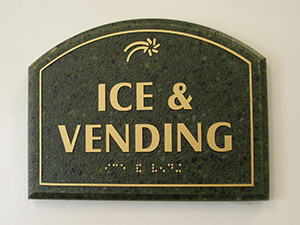
The most common question about ADA compliance is "What rooms are required to have ADA signs?"
It's a good question and the answer is can be kind of tricky. The short answer is: permanent rooms and spaces. See the ADA wording below. (Review the entire ADA regulations here).
Section 216.2 applies to signs that provide designations, labels, or names for interior rooms or spaces where the sign is not likely to change over time. Examples include interior signs labeling restrooms, room and floor numbers or letters, and room names. Tactile text descriptors are required for pictograms that are provided to label or identify a permanent room or space.
The key thing to remember is that if it's a room that is not likely to change, you are required to have an ADA sign identifying it. The restroom is always going to be a restroom and you should use an ADA sign to identify it. If the "Art Room" will be the "Science Lab" next year, an ADA sign with "Art Room" is not required.
With that in mind, a great way to identify rooms and guarantee compliance is to use a ADA window insert sign. A really common solution for identifying rooms that have varying purposes is to identify the room number with Braille characters and tactile lettering and add a window for a printable paper insert.
Remember, even if an ADA sign is not required, it's still a good idea. Making our buildings accessible to everybody is the right thing to do. And the cost to identify a room with an ADA sign versus a non-ADA sign is a few dollars more.
As always, we're happy to help with ADA questions. Please feel free to contact us!
Below is an example of a window sign. This type of sign can be made in any size and permanently identifies the room while providing a place for a description of the room function. Also check out the difference between photopolymer signs vs. raster braille signs.

